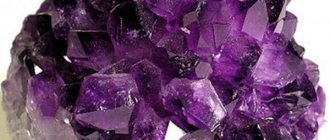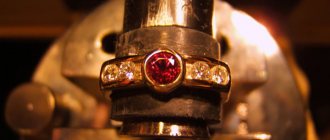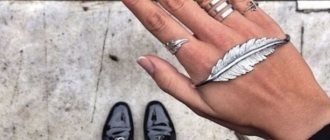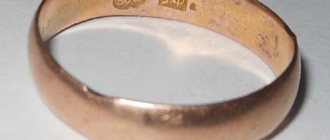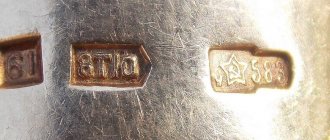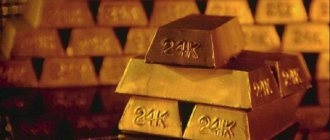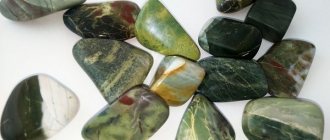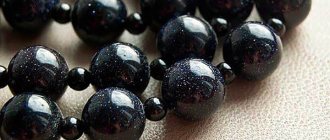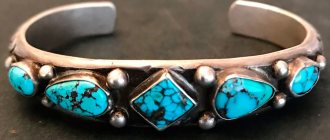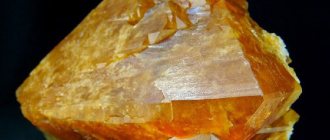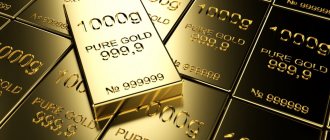Sooner or later, everyone comes up with the idea that it would be nice to go in search of native gold. This may be done with the thought of possible earnings or enrichment, or maybe it was simply interesting how much precious metal can actually be discovered. In any case, you will need to acquire not only the tools to find it, for example, a tray, but also certain knowledge, for example, how to distinguish pyrite from gold.
Pyrite stone
This problem arose quite a long time ago, prospectors found a certain mineral that they took for gold, but when tested it turned out to be far from gold. This substance was ferruginous pyrite and was popularly called “fool’s gold.” Its shine is similar to the shine of a precious metal due to the fact that inclusions of gold look slightly different in nature than in jewelry; an inexperienced miner can easily confuse them.
An interesting fact is that deposits rich in gold usually contain large quantities of pyrite similar to it. Therefore, mistakes were very common in those days. It turns out that you can find a gold nugget not only near pyrite, but also in it itself. Over time, such gold is washed out of the rocks and settles at the bottom, including the water that washes away the pyrite that is located around the nugget.
What is pyrite?
Pyrite is called iron pyrite. This is a material that has also been nicknamed "fool's gold". All because during the conquest of America by the conquistadors, this particular stone was mistaken for gold, they filled all the holds of the ship with it and brought it to Europe, where they discovered a fake. The real name of the mineral is translated as “stone that strikes fire.” Pyrite was confused with gold during the gold rush and the search for precious metals in Alaska. But such cases occurred less frequently, since gold miners were more literate than knights.
gold bar
Pyrite varieties and color
Minerals such as
- bravoit;
- marcasite;
- chalcopyrite,
are a variety of pyrite stone. The difference between minerals is in the chemical composition, hence the difference in color and structure. The most common colors of pyrite remain all shades of yellow from pale to rich gold.
Bravoit
Chalcopyrites or copper pyrites, due to their high content of copper and sulfur, have a wide range of colors and can shine with all the colors of the rainbow. Bravoites shine like steel due to their high content, up to 20% nickel.
Marcasite
Marcasite or spectropyrite contains cobalt and thallium. Lead, hence its golden-steel color and bright shine. This type of pyrite is prized by jewelers because it has clear crystalline edges and can shine in all colors. The mineral is very fragile, so jewelry with marcasite is not cheap and is considered expensive jewelry.
Chalcopyrite
Pyrite and marcasite - differences
The differences between pyrite and marcasite were discovered by the Australian chemist W. Heidinger, who studied the minerals for many years. Both pyrite and marcasite are included in the group of radiant pyrites and, despite their similar chemical structure, they also have differences.
- Different shapes of crystals. Pyrite has a strictly cubic structure, while marcasite crystals are rhomboid.
- Different crystal lattice.
- Marcasite rarely forms large crystals; it is used to decorate drip silver, where the crystals form a dense heterogeneous mass. Pyrite can form large blocks; the largest clump of fool's gold crystals weighed several tons.
Differences between gold and pyrite
But the real tragedy was that places of pyrite deposits were formed not far from gold deposits and always accompanied the precious metal. There are several differences that can be used to distinguish gold from pyrite. Distinctive features are based on the properties of the substances, since by their nature these are completely different materials. Some of the methods can be applied directly at the mining site, and some of the differences will reveal themselves over time. Among them there are such signs as:
- Form. It is different for these substances. Pyrite is a stone that has a crystalline structure. If such a substance is found, its structure will resemble a collection of crystals. Crystals can be seen with the naked eye. Pyrite will have sharp edges, but gold is a softer metal with rounded edges.
- The smell of the substances also varies. Pyrite contains sulfur in its composition, which is why it was also called sulfur pyrite. The formula of the substance is FeS2, which indicates iron disulfide. It contains 46.6% iron and 53.4% sulfur. Sulfur has a rotten odor that can be smelled even in small quantities. Therefore, if a substance has a specific aroma, then most likely it is pyrite in your hands. Gold doesn't smell like anything.
- Dimensions. Pyrite is a mineral with a crystalline form. Its dimensions can reach large figures. Gold occurs in the form of placers or small particles, even sand. Gold nuggets are very rare. Since the probability of this phenomenon is very low, all pieces of a golden hue larger than a pea are pyrite.
- Hardness is another feature that distinguishes pyrite from gold. If a precious metal has a very low hardness rating on the Mohs scale, then pyrite has a higher hardness rating. Iron pyrite is fragile. If you press on the gold with your finger, it will bend or the pin will enter the precious metal very easily, without resistance. But if you stick a pin into pyrite, it will crumble in this place and, even more so, will not bend under the pressure of your fingers. You can try a stone on your tooth the old fashioned way - the dent will remain on the gold.
- Another way to test is to rub it against white porcelain. In the case of gold, it will leave a yellow mark, but pyrite will leave a black mark. But the method is not suitable for all cases.
- Trying to test by scratching is similar to identifying a substance using the Mohs scale. In this case, a material with an intermediate hardness level is taken, for example, copper, and with its help scratches are applied to the substance being tested. If you have gold in your hands, then copper will leave a scratch on it. Well, if the find was pyrite, it means it will scratch the copper.
- In the light, pyrite tends to shine. But if the sun's rays do not fall on the stone, it will look dull. But gold always attracts with its soft shine.
- Pyrite can be used to create a spark. That is why it was used in the manufacture of firearms in the old days along with steel.
- You can tell two stones apart by density if you weigh equal sizes of two substances at the same time. Gold is denser, therefore, despite the pieces being identical in appearance, the gold will still outweigh.
- The fashion for decorating accessories or clothing with pyrite originated in France, but did not last long. The stone tends to quickly darken, and under the influence of oxidation from humidity it turns into limonite or rust. After a few years, the pyrite completely disintegrates. When exposed to oxygen, the stone decomposes, releasing sulfur dioxide with an unpleasant odor; Under the influence of water it turns into dangerous sulfuric acid. It is impossible to stop or slow down the process of mineral decomposition. If collectors want to preserve an exhibit, they place it in a special vacuum display case. But gold and its properties remain unchanged over time. Moreover, the precious metal does not react with practically anything, only with certain acids in concentrated form.
- Pay attention to the cost of materials. Pyrite will always cost less than gold since the mineral is a common stone. Even in Russia it is found in the Urals, Caucasus, and Altai. More often the stone is extracted from pyrite ores.
- If there are other differences in the resistance of substances, thermal conductivity of materials, their plasticity. But these differences can only be verified by processing them. You can take your find to a gemologist or jeweler for checking - they will immediately tell you the origin of the material.
But not everything is as bad as it might seem at first glance. Since pyrite occurs in association with gold mining sites, its discovery may indicate more valuable materials nearby. Or pyrite contains a small amount of real precious metal, albeit in the middle of the crystals. Don't immediately discard the find. Pyrite can be taken to a gemologist to examine its structure.
Despite the differences between the substances, both have their uses. Pyrite is an important substance in industry: sulfur, sulfuric acid, and ferrous sulfate are obtained from it. Stone is used as an additive to cement. But gold has found application in jewelry. The precious metal is also used in industry, but on a smaller scale. The value of both materials is incomparable, so in order to avoid falling into the hands of scammers, it is worth remembering the main differences between the substances.
Fool's gold - type and properties
Pyrite deposits are found all over the world and are almost always near a gold deposit. The color of pyrite is bright yellow, very similar to the color of pure gold , but the hardness of the stone is much higher than that of the precious metal. A pyrite nugget contains a lot of sulfur, so if you hit the stone against something hard, sparks will fly in all directions.
In nature, pyrite is often found in the form of crystals; in cooled lava, flat pyrite ingots were found that shone like a mirror. It was this reflective property that was widely used by the shamans of North America; today many esotericists use the stone as a kind of fortune teller’s ball - they read the future in it.
Fool's gold mineral - medicinal properties
Due to the concentrated composition of sulfur and iron, pyrite has great energy and occupies a high place in the field of stone therapy or stone therapy. The mineral has a beneficial effect on the human biofield, relieves depression and restores energy. Talismans, pendants and figurines made of pyrite will help with the following diseases:
- insomnia;
- impotence;
- cardiac disorders;
- expectant mothers;
- weakened immune system.
The stone helps with colds, in any case, people who wear a pyrite talisman claim that they rarely get sick from ARVI, and if they do, it’s only for a couple of days. I, Lyudmila (the author of the article), am skeptical about the properties of the stone itself, but I highly appreciate a person’s attitude, and if pyrite simply turns out to be a placebo , then even if it helps a person in this way.
Magic properties
Roman legionnaires and Greek warriors considered pyrite theirs. It was believed that this stone was the earthly embodiment of the god of war, Mars, and an amulet with it made the owner brave and protected from wounds.
The magical properties of the stone are also valued in the peaceful sphere. Sorcerers, psychics, and their other practicing colleagues do not skimp in order to take possession of an impeccable copy. Only a pebble with a smooth, solid surface, without chips or cracks, restores strength. Defective minerals attract problems.
Shiny pyrite crystals are powerful helpers for various purposes:
- peace of the family hearth, revival of marital feelings;
- success on the love front;
- eliminating conflicts at work and at home;
- protection from the elements;
- energy supply at the mental and physical levels;
- concentration for action in extreme situations.
Pyrite amulet
Pyrite cubes are talismans and amulets for people in risky professions: police officers, emergency workers, hot shop workers, firefighters, stuntmen. The owners of such a talisman become calmer and more resilient.
The stone is suitable for real and potential leaders.
However, this is a “highly moral” mineral; its magic only helps in actions with a plus sign. Liars, cunning people, dishonest people risk having the negative message sent back. In a favorable scenario, the value of the stone for them will be zero.
How to wear and care
The energy of the stone is such that strong-willed people can constantly interact with it.
For the rest, esotericists recommend wearing jewelry for no more than three days in a row. Otherwise, a nervous breakdown, irritability, even insanity are guaranteed.
The mineral is delicate; the following are contraindicated:
- falls, mechanical impacts;
- prolonged exposure to the sun;
- household chemicals;
- proximity to other stones.
Even ordinary conditions are not suitable: within a few years, untreated pyrite crumbles in air. This is probably where the legends about old pirate treasures that became dust came from. The earth or deep sea destroys the mineral faster.
For safety, experts recommend covering dry items or crystals in jewelry that are free of oxides and dirt with colorless nail polish or soaking them in vegetable oil. Owners of pyrite items say that in this form they retain their original appearance and last for many years
.
Caring for collectible exhibits is troublesome. Oxygen in the air decomposes the mineral, and water that gets on the stone creates sulfuric acid, which is destructive to the exhibit.
Pyrite bracelet
Therefore, it is better to store fossils with pyrite in vacuum packaging. It's expensive and not available to everyone. It is cheaper, following the example of museum workers, to boil it over low heat in paraffin or rosin. The procedure can be done at home, but only a vacuum provides a complete guarantee of the safety of structurally heterogeneous samples.
Mineral deposits
Pyrite cubes in rock
Pyrite is not specifically mined, as it is economically unjustified. It is obtained by working with pyrite ore during the extraction of more valuable rocks - lead, copper, tin, zinc and other non-ferrous metals.
In nature, the mineral looks like a cluster of smooth and shiny cubes with clear edges. Jewelry samples are supplied mainly from Italy. Russia, the USA, Canada and Japan use the “mined” mainly for industrial purposes, obtaining sulfur, sulfuric acid and ferrous sulfate from the mineral, and also as a corrective additive in the process of cement production. There are also pyrite deposits in Spain, Kazakhstan and Norway.
Selective Extraction Technology
The rationale for choosing selective technology with minimal capital and operating costs was based on the following aspects and limitations:
1) it is necessary to extract metals at the site where the tailings are stored, avoiding the costs of their excavation and movement, i.e., using the underground leaching method;
2) high gold recovery rates are achieved with preliminary oxidation/opening of pyrite;
3) the extraction of copper and zinc, as well as the oxidation of pyrite, is advisable to carry out in acidic environments - using solutions of sulfuric acid with additives of oxidizing agents;
4) to extract gold, it is advisable to also use sulfuric acid solutions with thiocarbamide additives.
This approach was tested during 2020–2021. on a technological sample of tailings from the processing plant of PJSC Gaisky GOK, %: 0.24 - copper; 0.24 - zinc; 20.9 - iron; 25.1 - sulfur; 0.8 g/t - gold and 8.2 g/t - silver. The work was carried out jointly with Ural Geotechnological Company LLC. The research was preceded by a study of the filtration properties of stale tailings and the characteristics of the hydrogeological conditions of the tailings dump, according to which moderately favorable hydrogeological conditions were determined for organizing the leaching process at the site.
Laboratory studies on metal leaching were carried out in percolation columns in filtration and infiltration modes - comparable data were obtained on the extraction of copper and zinc into leaching solutions (~40% each). The possibility of obtaining productive solutions with concentrations of copper and zinc of 2–4 g/dm3 with minimal extraction of iron into leaching solutions has also been determined. Copper was precipitated from productive solutions by cementation on iron filings, and zinc in the form of sulfide cake.
Next, without unloading the cake from the percolators, bacterial oxidation of pyrite was carried out using Acidithiobacillus bacteria (A. ferroxidans and A. thiooxidans). Oxidation proceeded very slowly—in 94 days, ~15% of pyrite was oxidized. However, this is sufficient to recover 30–40% of gold during subsequent thiourea leaching. Solutions with a gold concentration of 0.1–0.2 mg/dm3 were obtained. The residual gold content in the tailings after leaching was 0.5 g/t. Gold was extracted from productive solutions by sorption on activated carbon.
Based on the research results obtained, a fundamental technology for extracting gold, copper and zinc from enrichment tailings by in-situ leaching was also developed. A preliminary feasibility study showed the attractiveness of the developed technology. It is important to note that this method has reserves for increasing the extraction of metals due to additional oxidation of pyrite. Currently, studies are being conducted to assess the influence of the degree of pyrite oxidation on the completeness of subsequent gold recovery.
When comparing the parameters and indicators of an integrated and selective technology for extracting metals from stale pyrite tailings, the latter looks more preferable due to lower capital and operating costs, lower cost of gold extraction, and minimization of environmental and financial risks. Development of the technology continues at the UMMC Technical University.
Place of extraction
Pyrite is found almost everywhere on the planet. The largest deposits of the mineral are in Russia (Ural) and the USA. Small accumulations are found in Europe.
Specimens in condition suitable for processing and use are rare. Almost everything is supplied by Italy. In South Africa, material with uranium impurities is mined.
The shine of pyrite layers means the presence of gold nearby. This proximity makes the mineral look like a noble metal.
Pyrite can be found near hot springs. The stone is not mined separately, but is extracted from ore containing cobalt, zinc or copper.
Who is recommended to wear pyrite according to zodiac signs?
Jewelry and amulets made of sulfur pyrite can be worn by everyone. This will have a beneficial effect on your health and improve your emotional state. But the magical properties of pyrite are available only to people who are protected by the element of Fire.
A lion . Pyrite jewelry strengthens the family unit and gives a “second youth” to couples who have been married for more than 20 years.
Aries . The fire stone will awaken the desire to improve and bring emotional health. Failures will not be so acutely experienced if you wear a ring with pyrite on the index finger of your right hand.
Sagittarius . The mineral will help you find peace of mind, strengthen your aura and enhance your intuition.
For other zodiac signs, the stone will not become an amulet, but will help in family life, career issues and well-being.
Who should not wear fool's gold mineral
There are two zodiac signs that should not wear a fire stone. These are Cancers and Virgos. Cancers quickly fall under the influence of the mineral, become indecisive, and their careers may decline.
Earthy Virgos may wear pyrite jewelry from time to time when difficult decisions need to be made. Having placed the stone in front of you, you need to ask it for advice. The mineral will “tell you” a way out of the peak situation. After talking with pyrite, the problem will be resolved.
Amulets and talismans
Pyrite is a unique amulet for people whose professions involve risk to life. These are firefighters, construction workers, and military personnel.
Talismans made from the mineral will protect them from danger. It is also recommended to be worn by those associated with the law. The stone will help you make fair decisions.
A mineral amulet will protect the house from enemies and ill-wishers. In love magic, a pyrite talisman can attract love and rekindle faded feelings.
